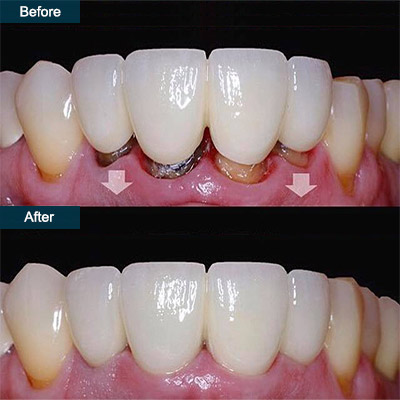Does Dental Insurance Cover Gum Grafting?

Yes, dental insurance may cover gum grafting procedures.
What Is Gum Grafting?
Gum grafting is a dental procedure that involves taking healthy gum tissue from one area of the mouth to cover and protect exposed tooth roots or areas of receding gums. This treatment is essential for maintaining good oral health as it helps prevent tooth loss, sensitivity, and further gum recession.
Gum grafting is performed by a periodontist, who will first numb the area to ensure a comfortable experience. Then, a small incision is made in the gum, and the healthy tissue is carefully placed over the affected area. Over time, the transplanted tissue integrates with the existing gum, providing added protection and support.
It is important to note that dental insurance coverage for gum grafting procedures can vary. Some insurance plans may cover a portion of the cost, while others may not provide any coverage at all. It is advisable to consult with your dental insurance provider and discuss the specifics of your coverage before undergoing the procedure. This will help you understand any out-of-pocket expenses you may incur for gum grafting.
| Benefits of Gum Grafting | Prevention of further gum recession | Protection against tooth sensitivity | Preservation of tooth structure | Enhanced aesthetics |
|---|---|---|---|---|
| Importance for Oral Health | Gum grafting is crucial for maintaining oral health, as it helps prevent tooth loss by strengthening the surrounding gums. | Exposed tooth roots can cause extreme sensitivity to hot and cold foods. Gum grafting protects these roots, reducing sensitivity and improving comfort. | Receding gums can lead to the loss of tooth structure. Gum grafting covers the exposed areas, preserving the integrity of the teeth. | Gum grafting can improve the appearance of the smile by creating a more even gumline and reducing the appearance of exposed roots. |
Dental Insurance And Coverage
Gum grafting is a dental procedure that involves taking gum tissue from one area of the mouth and grafting it onto another area that has receded or lacks sufficient gum tissue. As with any dental treatment, the coverage provided by dental insurance for gum grafting depends on various factors.
| Factors | Influence on Insurance Coverage |
|---|---|
| Insurance Plans | The type of insurance plan you have plays a significant role in determining coverage for gum grafting. Some plans may cover the procedure partially or fully, while others may not include it in their coverage. |
| Reason for Procedure | Insurance coverage for gum grafting may vary depending on the reason behind the procedure. If the grafting is necessary for functional purposes like tooth protection or restoration, it is more likely to be covered compared to grafting solely for cosmetic reasons. |
| Prior Authorization | Some insurance providers may require prior authorization for gum grafting. This means that you need to obtain approval from the insurance company before undergoing the procedure to ensure coverage. |
| In-Network Providers | The dental professionals you choose can also impact insurance coverage. Working with an in-network provider increases the likelihood of receiving coverage since they have agreed-upon fees and terms with the insurance company. |
In conclusion, dental insurance coverage for gum grafting varies based on factors such as the type of insurance plan, the reason for the procedure, prior authorization requirements, and the choice of in-network providers. It is essential to consult with your insurance provider and dentist to understand the specific coverage details for gum grafting under your dental insurance plan.
Does Dental Insurance Cover Gum Grafting?
When it comes to dental insurance, coverage for gum grafting will vary depending on certain criteria. One of the main factors is the type of dental insurance plan you have. There are typically three types of dental insurance plans: indemnity plans, preferred provider organization (PPO) plans, and health maintenance organization (HMO) plans.
Indemnity plans provide the most flexibility, allowing you to choose any dental provider you want. PPO plans offer a network of dentists to choose from, and HMO plans require you to visit a dentist within a specific network.
To assess coverage for gum grafting, you should review your dental insurance policy or contact your insurance provider directly. They will be able to provide specific information on whether gum grafting is covered and if any limitations or restrictions apply.
It’s important to note that dental insurance policies can vary widely, so it’s best to confirm coverage before undergoing any dental procedure. Understanding your coverage can help you plan and budget for out-of-pocket expenses related to gum grafting or any other dental treatments.
Common Dental Insurance Coverage Limitations
When it comes to dental insurance coverage, it is important to understand the limitations and exclusions that may apply. Gum grafting is a common procedure that aims to treat gum recession by replacing or restoring the gum tissue. However, not all dental insurance plans cover this treatment.
One limitation to be aware of is pre-authorization and waiting periods. Some insurance plans require pre-authorization or may have waiting periods before coverage for gum grafting becomes effective. This means that you may need to obtain approval from the insurance company or wait for a specific period of time before undergoing the procedure.
Another consideration is the annual maximums and frequencies for treatment coverage. Dental insurance plans often have an annual maximum, which is the maximum amount they will pay for all dental treatments in a calendar year. If the cost of gum grafting exceeds this maximum, you may be responsible for covering the remaining expenses. In addition, insurance plans may have limitations on the frequency of coverage for certain treatments, including gum grafting.
Understanding Out-of-pocket Expenses
Co-pays and Deductibles
In the realm of dental insurance, it is crucial to comprehend the extent of coverage for gum grafting procedures. Out-of-pocket expenses play a significant role in determining the overall cost burden for such treatments. Be aware of the impact that coverage limitations can have on your financial responsibilities.
Co-pays, or the fixed amounts you have to pay for each visit or service, can accumulate quickly for gum grafting. Ensure you are well-informed about your dental plan’s co-pay requirements to avoid unwelcome surprises.
Deductibles, on the other hand, represent the initial amount you must pay before insurance coverage kicks in. It is crucial to know and factor in your deductible amount to gauge the true out-of-pocket costs for gum grafting.
Unfortunately, various dental insurance policies include limitations and restrictions for gum grafting coverage. These limitations can lead to higher out-of-pocket expenses, placing a significant financial burden on individuals seeking this particular treatment.
However, it is important to explore options available for managing expenses. Some dental insurance providers offer supplementary plans or options to cover certain procedures, including gum grafting. Research and inquire about these alternative options to alleviate the out-of-pocket costs associated with gum grafting.

Credit: www.dentistinbrooklyn.com
Insurance Alternative: Dental Financing Programs
Dental insurance typically covers a wide range of dental services, but when it comes to gum grafting procedures, coverage may vary. In most cases, dental insurance plans consider gum grafting to be a medically necessary procedure and provide partial coverage. However, it’s important to check with your insurance provider to understand the specific details of your plan.
If dental insurance doesn’t cover gum grafting or if you don’t have dental insurance, there are alternative options available such as dental financing programs. These programs aim to make dental procedures more affordable by offering flexible payment plans.
With dental financing programs, you can receive the necessary gum grafting treatment and spread out the cost over time. This can be especially beneficial if you’re facing a significant out-of-pocket expense.
However, it is important to consider the potential drawbacks as well. Some dental financing programs may charge interest or fees, which can increase the overall cost of the procedure. Additionally, not all dental providers may accept these financing programs, so it’s important to find a provider who does.
| Benefits | Drawbacks |
|---|---|
| Flexible payment plans | Potential interest or fees |
| Spread out cost over time | Not accepted by all dental providers |
Maximizing Dental Insurance Coverage
htmlMaximizing Dental Insurance Coverage
When it comes to gum grafting and dental insurance coverage, there are a few tips that can help you optimize your benefits. Communication with insurance providers is key. Make sure to understand the details of your dental insurance policy, including what is covered and any limitations or exclusions that may apply.
Utilization of in-network providers can also help maximize your coverage. Check if your dental insurance plan has a network of preferred providers and make sure to seek treatment from them. In-network providers often have negotiated rates with insurance companies, which can result in lower out-of-pocket expenses for you.
By staying informed and utilizing in-network providers, you can optimize your dental insurance coverage for gum grafting.
Additional Considerations
Maintaining good oral health is crucial to prevent gum recession, which may lead to the need for gum grafting. This includes proper brushing and flossing techniques, regular dental check-ups, and avoiding habits like smoking. While dental insurance typically covers gum grafting, it’s important to review your policy for specific details.
Aside from dental insurance, there are other alternatives to consider for gum grafting coverage. Some employers offer flexible spending accounts (FSAs) or health savings accounts (HSAs) that can be used for dental procedures. Additionally, some dental practices offer payment plans or financing options to help make gum grafting more affordable.
When choosing a dental insurance plan, there are several factors to consider. These include coverage limits, deductible amounts, coinsurance percentages, and any waiting periods for pre-existing conditions. It’s also important to check if the insurance plan includes coverage for other dental procedures, such as cleanings, fillings, and extractions.
In summary, while dental insurance generally covers gum grafting, it’s important to maintain good oral health to prevent gum recession. Exploring alternatives like FSAs, HSAs, payment plans, and financing options can also help make gum grafting more accessible. When selecting a dental insurance plan, consider factors such as coverage limits, deductibles, coinsurance, and other covered procedures.
Frequently Asked Questions On Does Dental Insurance Cover Gum Grafting?
How Expensive Is A Gum Graft?
A gum graft can vary in cost depending on factors like location and severity of the issue. Generally, the expense can range from $600 to $2,000 per graft.
Do I Qualify For A Gum Graft?
To qualify for a gum graft, you should consult with a dentist or periodontist who will evaluate your specific situation. Factors considered include the extent of gum recession, overall gum health, and the availability of donor tissue. They will then determine if a gum graft is a suitable treatment option for you.
Can A Regular Dentist Do Gum Graft?
Yes, a regular dentist can perform a gum graft procedure. They have the necessary skills and training to offer this treatment to patients.
Is Gum Grafting Worth The Money?
Gum grafting may be worth the money as it can improve the appearance of receding gums and protect tooth roots from damage. It also helps to prevent tooth sensitivity and loss. Overall, gum grafting can enhance oral health and preserve your smile.
Conclusion
To summarize, dental insurance coverage for gum grafting varies depending on the specific plan and its policies. Consulting with your insurance provider is crucial to understanding the extent of coverage for this treatment. Remember to thoroughly review your policy documents, inquire about pre-authorization requirements, and consider alternative financing options if necessary.
Prioritize your oral health and explore how dental insurance can support your gum grafting needs.






One Comment